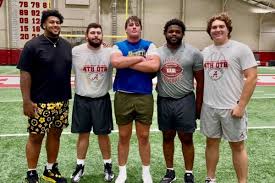Shockwaves are reverberating through the NFL and college football landscapes after reports emerged that Cincinnati Bengals’ first-round draft pick Shemar Stewart has left the team to return to Texas A\&M, potentially setting a precedent for how young athletes navigate their professional and collegiate careers. The news has sent both the Bengals organization and the broader football world into a frenzy, with speculation about Stewart’s future and the implications of this stunning move dominating sports headlines. For a player who was expected to be a cornerstone of the Bengals’ defense for years to come, this development feels almost surreal.
Stewart’s decision is rooted in an unorthodox approach to his career trajectory. Selected by the Bengals in the first round, Stewart was expected to immediately inject power and explosiveness into their defensive line. Known for his freakish athleticism and raw strength, he was considered a “can’t miss” prospect, someone who could develop into one of the league’s most feared pass rushers. However, the transition from college to the professional game can be daunting, and it appears Stewart may have felt that the timing was not yet right for him to fully commit to the NFL grind. By returning to Texas A\&M, Stewart is essentially hitting the reset button, opting to refine his skills in a familiar environment rather than facing the steep learning curve of the NFL head-on.
The Bengals’ front office must be stunned by this unexpected twist. Drafting a player in the first round comes with enormous investment, both financially and in terms of organizational planning. Stewart was supposed to be part of their long-term vision for a defense built around youth and versatility. For him to leave just months after being drafted is not just a personal decision but one that could affect the team’s immediate and future strategies. Cincinnati was counting on Stewart to pair with their established veterans and inject life into a pass rush that has been inconsistent. His departure leaves a sizable void that the team may now have to fill through free agency or trades, further complicating their preseason preparations.
What makes Stewart’s move even more intriguing is the potential path forward. Reports indicate that he could apply for a waiver with the NCAA to play in the 2025 season for Texas A\&M. If granted, this would allow him to re-enter the 2026 NFL Draft, essentially giving him a second chance at professional football with more experience and maturity under his belt. While this might sound appealing from Stewart’s perspective, it also comes with significant risks. Injury concerns, performance inconsistencies, and the unpredictability of future draft evaluations could all impact his stock when he eventually re-enters the draft pool. It’s a gamble, but one Stewart appears willing to take in order to regain control of his career timeline.
From Texas A\&M’s perspective, Stewart’s return is nothing short of a gift. As one of the most talented defensive linemen to come through their program in recent years, his presence will instantly elevate the Aggies’ defense. A\&M’s coaching staff will no doubt welcome him back with open arms, seeing his return as a chance to strengthen their defensive front and compete at the highest level in the SEC. His leadership and NFL-caliber experience will also serve as a motivating factor for younger players on the roster, who can now look to Stewart as both a teammate and a mentor.
This situation also raises interesting questions about NCAA rules and the evolving landscape of college football. With NIL (Name, Image, and Likeness) opportunities providing financial incentives for college athletes, it is no longer a simple choice between staying in school and going pro. Players like Stewart might find it more appealing to stay in college a little longer, knowing that they can still earn money while developing their skills and increasing their draft value. If the NCAA grants Stewart a waiver, it could open the door for similar cases in the future, where players decide to return to school after a short stint in the NFL, provided certain conditions are met.
Stewart’s story also underscores the immense pressure placed on young athletes entering the NFL. The leap from college to professional football is not just about talent; it requires mental toughness, adaptability, and the ability to navigate the business side of sports. Not every player is ready to make that leap at 21 or 22 years old. For Stewart, the decision to return to a college setting might be a way to ensure that when he does return to the NFL, he’s better prepared for the challenges ahead. Rather than being remembered as a player who “couldn’t handle the NFL,” he may ultimately be seen as someone who had the foresight to take a step back in order to take two steps forward.
The Bengals, however, must now assess the damage. The organization has already invested time and resources into Stewart’s development, and losing him leaves both short-term and long-term questions unanswered. How do they replace his talent on the roster? Do they hold out hope that Stewart might return to the team in some capacity, or do they move forward as if he’s gone for good? Fans, too, are left wondering what this means for the upcoming season. Cincinnati had high hopes for Stewart’s impact, particularly given the competitive nature of the AFC North, where every pass rush and defensive stop can make the difference between a playoff berth and an early offseason.
Moreover, Stewart’s move might inspire other young players to reevaluate their paths. If a first-round pick can walk away from the NFL, even temporarily, it sends a clear message that the traditional progression from college to pro is no longer the only viable option. It’s possible that Stewart’s case becomes a unique example rather than a trend, but the ripple effects will be worth monitoring in the years to come. Coaches, general managers, and agents will now have to consider the possibility that a player might decide to take this kind of detour.
There is also the matter of Stewart’s reputation and brand. While some critics may view his decision as a sign of weakness or indecision, others will respect his courage to take control of his future. Athletes today are increasingly aware of their own personal brands and long-term earning potential. Stewart’s decision, while risky, might actually boost his image as someone who prioritizes personal growth and development over immediate financial gain. If he returns to college, dominates in the SEC, and re-enters the NFL Draft as an even more polished player, his narrative could shift from controversy to redemption.
For now, all eyes are on the NCAA to see if Stewart’s waiver request will be granted. If he is cleared to play for Texas A\&M in 2025, it will add a dramatic new chapter to the upcoming college football season. Fans of the Aggies will undoubtedly be ecstatic, while NFL fans will watch closely to see how this experiment unfolds. The idea of a first-round draft pick stepping away from the professional game, only to return later, is virtually unheard of, which is why this story has captured so much attention.
Ultimately, Shemar Stewart’s decision is a reminder that athletes are not just assets or commodities; they are individuals with unique goals, challenges, and timelines. His choice to walk away from the Bengals and head back to Texas A\&M is shocking, yes, but it also reflects the evolving nature of sports careers in the modern era. As we wait for more details and official statements from Stewart, the Bengals, and Texas A\&M, one thing is certain: this saga is far from over, and its impact will be felt across both the NFL and college football for years to come.
In the coming months, we will learn whether Stewart’s gamble pays off. If he thrives at Texas A\&M, improves his draft stock, and returns to the NFL as a better version of himself, this move will be hailed as a masterstroke. If, however, injuries or performance issues derail his plans, the decision could be remembered as a misstep. For now, Stewart’s boldness has ensured that his name will be at the center of conversations in both college and professional football circles, a testament to the seismic shock this news has sent through the sports world.



